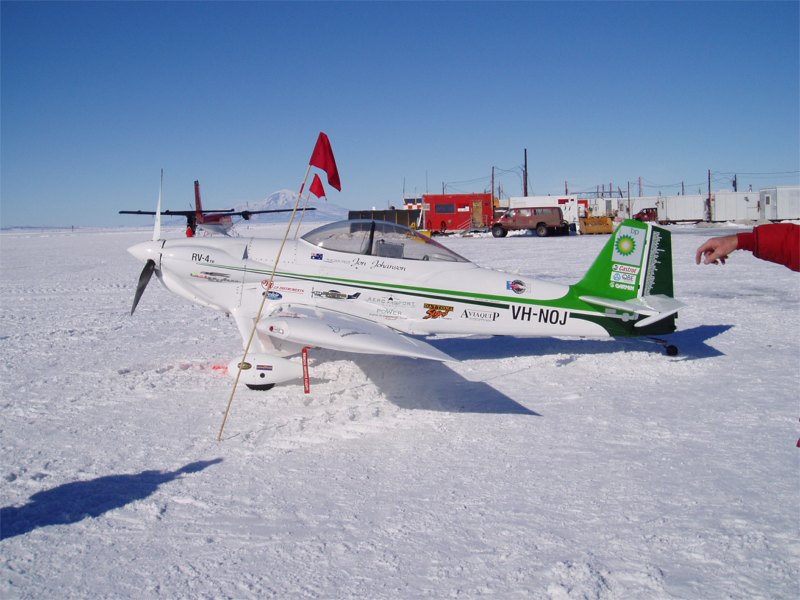Jon Johanson at McMurdo

...here he is parked at the ice runway after arriving 8 December 2003 (photo from Jordan Dickens)
...and Jon Johanson at Pole!
2018 UPDATE: Nicholas Johnson at Big Dead Place had an April 2004 detailed interview with Jon (archive) by an unidentified Polie!...and an updated link to the 19 April 2004 ABC News Australia an interview with Jon about his future plans.
|
The above left photo shows Jon heading north above the skiway...a few moments later he did a 180 to the left and headed back to McMurdo. Polies didn't get much warning of the visit. This photo by w/o AMANDA guy Ethan Dicks shows the RV-4 to the right of Nick Tothill on the stairs to the roof of AST/RO. At right is another view by NOAA guy Glen Kinoshita who was at ARO. This turned into an interesting diplomatic flap between Australia and NZ. On early Monday 15 December (+13) he took off, arriving in Invercargill 12 hours later. He returned to Adelaide the following day. Here's a 15 December USA Today article covering his arrival back at Invercargill. As of Sunday afternoon (14 December) McMurdo time Jon had refueled and was ready to go except for the weather. There was a bit of a storm between New Zealand and Antarctica...and the NZ and US programs were refusing to furnish met information. So Jon had to get it from his office in Australia. Polly Vacher (May 2004 BBC News article) had been underway to cross the continent in the opposite direction, and had stockpiled avgas at Scott Base privately last year. Since she too ran short of fuel at Rothera, she cancelled her transpolar flight and offered to let Jon use 400 liters of her cache. The NZ program helped transport and load the fuel so Jon could be headed back to NZ. Here's a Saturday, 13 December satellite interview with Jon by ABC News Australia. This was NSF's press release on the situation (with a neat video on Antarctic logistics). Here is a transcript of an interview with Dick Smith by ABC News Australia. Dick Smith himself had flown uninvited to Pole in November 1988). McMurdo officials told folks to offer Jon no assistance; they proposed to fly him north to Christchurch on one of the scheduled flights, ship his aircraft north in January, and send him a bill. Jon, of course, balked at that. Jon arrived at the ice runway on Monday, 8 December after leaving Invercargill Sunday on what was supposed to be a 33-hour flight to Argentina. He was spotted at Pole before he turned around for lack of fuel and returned to McMurdo--after covering about 3750 statute miles during 26½ hours in the air. He said he had a 35-hour supply of fuel...but his radio conversations with McM on the way down indicated he was experiencing stronger than expected headwinds and already knew he wouldn't have enough to complete the flight. He claimed that he was only an hour short. The aircraft is a specially modified RV-4, which is probably the most popular homebuild kit aircraft. The base design is a 2-seater with a 32-gallon tank and perhaps a 5-hour flying range with a standard engine. However, this aircraft has a special long-range engine and additional fuel storage in the rear seat and cargo space. Johanson has previously flown this aircraft around the world 3 times including a trip over the North Pole (here's the Van's Aircraft specs page on the base RV-4, and another page about some of Jon's previous exploits). Jon had asked for the equivalent of 2 55-gallon drums of aviation gasoline to permit him to return to NZ...however it is not the policy of the NZ and US Antarctic programs to supply fuel to unsanctioned private travelers; their policy is that private expeditions should be self-sufficient and arrange their own insurance for search and rescue. Plus, the Madrid Protocol of the Antarctic Treaty requires environmental assessments for all ventures to the ice, presumably Jon didn't do one. (I asked about that pink stuff on the snow under the engine, that is not a leak, just marker paint to indicate his parking space.) There were problems with fuel availability as well. Neither the US nor NZ normally use aviation gasoline (120-140 octane) as the LC-130's and Twin Otters use JP-8. The only gasoline available is regular 87-octane unleaded gas used in motor vehicles. Jon had asked for some of that...use of which could further compound the liability to the program if his engine would balk somewhere over the Southern Ocean... Jon filed a flight plan for his trip just before departing, but he kept his South Pole plans secret until the end, knowing that they would not be approved. He claims to have done his homework on Antarctic flying and weather conditions, but depending on the actual weather situation, there were several other hard-surface runways he could have diverted to instead of McM---Patriot Hills, Novo, Rothera, or even Marsh...at any of these he might have had an easier time getting refueled. And his tires were too small for the ice runway...since he didn't have the oversized low-ground-pressure balloon tires such as used by the Twin Otters, the wheels sank into the snow and he had to get assistance in getting towed off of the active airstrip. Accordingly, for his takeoff, Jon chose to use the ice road which was more compacted than the runway. Here are a few more pictures from Jordan Dickens (2, 3, 4, and 6) and the McM common drive. | |

